#office de tourisme
Text
Etiennette de Castellnou !
Etiennette de Castellnou !
Quel délicieux et charmant petit village médiéval ! Lové au coeur du maquis catalan environné de cistes, genets, bruyères et chênes méditerranéens, c’est un havre de quiétude. Quelques vignes s’obstinent encore à pousser, vestiges de l’activité agricole d’antan du village. Le temps semble là immobile. Quand déboule l’Eté, il faut les entendre, les cigales chanter à tut tête comme pour faire taire…

View On WordPress
#agriculture#Canigou#Castelnou#CULTURE CATALANE#Les Aspres#OFFICE TOURISME COMMUNAUTAIRE DES ASPRES#Perpignan#Pyrénées#Roussillon#Thuir
1 note
·
View note
Text



The historic centre of Brașov (Brassó/Kronstadt), photographed from what is today Str. Mureșenilor, ca. 1925
On the awnings of the buildings you can see several interesting names:
Klingsor (1924–1939), on the right, was a German-language illustrated cultural journal aimed at a Transylvanian Saxon audience. The building now houses the local branch of the National Bank of Romania.
Gazeta Transilvaniei (1838–1944), towards the middle, was the first Romanian-language newspaper published in Transylvania (under the name Gazeta de Transilvania). That building now houses a Raiffeisen Bank and the local PSD (Social Democratic Party) office.
Below the Gazeta Transilvaniei office is Wilhelm Scherg & Co. Scherg founded the first textile factory in the area and it eventually grew to be the largest in Romania. After nationalization in the communist era it became Carpatex, which still operates today.
Albina, towards the left, was the name of a bank based in Sibiu (Hermannstadt/Nagyszeben). Founded in 1871, it was the successor of an economic cooperative, inspired by those run by Transylvanian Saxons, aimed at creating a separate economic institution for Romanians in Transylvania. It operated until 1948. That building now houses a 5 To Go coffee shop and a Karpaten tourism office.
In the foreground you can see an oxcart (un car cu boi, how typically Romanian!) and some smartly-dressed people crossing back and forth from Piața Sfatului. Looming in the background is Biserica Neagră (die Schwarze Kirche / the Black Church), completed in the 15th century.
via Photo Historia
54 notes
·
View notes
Text




People from Arles and els Banys i Palaldà (Northern Catalonia) celebrating the Festa de les Mules (Mules Festivity) also called Festa de Sant Eloi (Saint Eligius' Feast).
This festivity is celebrated annually around June 25th in towns of the Vallespir area of Northern Catalonia. It's fixed on this day because it's the Feast of Saint Eligius (Sant Eloi), who is the patron saint of horses, mules, donkeys, and those who work with these animals.
This tradition celebrates mules, an animal that was very commonly used in agricultural work until only a few decades ago. On this day, all the farmers used to bring their mules to the church to get blessed. Nowadays, they still bring the few mules that are still in the area, and the day has become to remember this job that used to be so important for survival.
The festivity of Sant Eloi is also celebrated similarly in other parts of Catalonia (see this post about Els Elois in Berga).
Photos from L'indépendant and Office du Tourisme d'Amélie-les-Bains.
#festa de les mules#festa de sant eloi#sant eloi#tradicions#arles#els banys i palaldà#els banys d'arles#catalunya nord#mules#animals#pays catalan#folk clothes#europe#travel#culture#cultures#folk culture#folklore
30 notes
·
View notes
Text







Marseille en août. Le Musée Regards de Provence (anciennes consignes sanitaires à l'architecture moderniste) présentait deux expos.
Celle-ci, "Marseille au cœur maritime" montrait quelques pièces de l'ancien Musée de la Marine de Palais de la Bourse, scandaleusement disparu...
Quelques affiches :
Roger Broders - "Marseille, la grande métropole industrielle et commerciale"
Troy - "Fabre Lines, Marseilles, Mediterranean Great Lakes Services". (Ah bon ? Un service de bateaux marseillais sur les Grands Lacs ?? Si quelqu'un sait de quoi il s'agit, j'aimerais des éclaircissements...)
J.Daviel - "Marseille- Alexandrie, la Route de l'Egypte"
Beglia - "Marseille, Syndicat d'Initiative, Office du Tourisme"
Ray Piollenc - Le Monde entier passe par Marseille" (bon, c'est un peu exagéré...)
Roger Broders - "Marseille, Porte de l'Afrique du Nord"
Raoul Berjonneau - "Société Générale de Transports Maritimes"
#marseille#regards de provence#musée regards de provence#musée de la marine#marseille au coeur maritime#affiche#roger broders#troy#fabre lines#grands lacs#great lakes#j.daviel#alexandrie#égypte#pharaon#beglia#drapeau#raypiollenc#raoul berjonneau#SGTM#oranie#algérie#sicard
7 notes
·
View notes
Text
Idées de lieux de rp originaux
École
Salle des profs
Garde-robe
Passage secret
Derrière le gymnase
Chaufferie
Toîts
Salle de perm
Préau
Salle des casiers
Couloir des trophées
Ville
Boulangerie
Banque
Mairie
Barbier
Cordonnerie
Tannerie
Cartographe
Boutique mystique
Garderie pour enfants
Étable, écurie
Cimetière
Blanchisserie, pressing
Horloger
Rails ferroviaires
Office du tourisme
Aéronef
Égouts
Bureau de poste
Karting
Cabine téléphonique
Photomaton
Costumerie
Vétérinaire
Pigeonnier
Prêteur sur gage
Puits
Catacombes
Cathédrale
Fast Food
Aire de jeux
Kiosque à journaux
Mondes + étendus
Ferme
Dongeon
Monastère
Portail magique
Île flottant dans le ciel
Territoire d'une bête
Tour de guet
Pont
Épave de bateau, vaisseau abandonné
Phare
Maison de sorcière
Labyrinthe
Cercle de pierres
Moulin
Sources chaudes
Abri côtier
Grand arbre sacré
Tombeau
Autel à un/des dieu(x)
Lac aux lucioles
Falaises escarpées
Serre
Piège (genre un gros trou)
Oasis
Campement
Cavernes & souterrains
Caverne à champignons
Caverne à stalactites
Mine de cristaux
Mine pleine de lave
Caverne à peintures rupestres
Caverne submergée
Caverne glacée
Tunnel mal éclairé
Rivière souterraine
Weirds +++
Abattoir
Maison close
Fourrière
Fight club
Derrière un tableau avec des trous
Quartier des pestiférés, zone de quarantaine
Antenne relai, antenne radio
Freak show
7 notes
·
View notes
Text
The number of short-term Airbnbs available in New York City has dropped 70 percent after the city began enforcing a new law requiring short-term rental operators to register their homes. But despite the new requirements, there are still thousands of listings that could be unregistered.
The drop, recorded between August 4 and September 5, the day New York City began enforcing the new law, represents the disappearance of some 15,000 short-term listings from Airbnb. The figures are based on data provided by Inside Airbnb, a housing advocacy group that tracks listings on the platform.
In August, there were some 22,000 short-term listings on Airbnb in New York City. As of September 5, there were 6,841. But it seems some short-term listings have been switched to long-term listings, which can only be booked for 30 days or more. The number of long-term rentals jumped by about 11,000 to a total of 32,612 from August 4 to September 5. These listings do not need to be registered under the new law.
Additionally, Inside Airbnb estimates that around 4,000 rentals in total have disappeared from Airbnb since the law took effect.
That uptick in long-term rentals may show that the law is working, by pushing hosts to offer apartments to those staying in New York City for 30 days or more. The new registration requirement is meant to enforce older rules on short-term rentals in the city, and it comes at a time when New Yorkers face high rents and housing insecurity. Vacation rentals are also known for bringing noise, trash, and danger to residential neighborhoods and buildings.
At a glance, it’s impossible to tell if a listing on Airbnb is registered with the city. Inside Airbnb found that only 28 short-term rentals in New York mentioned having a registration number from the city in their listing, but it’s not immediately clear if those numbers are legitimate, and the number of short-term rentals Inside Airbnb found far outpaces the number the city has registered.
Ultimately, hosts will need to display registration numbers on their listings. New York City has received 3,829 registration applications, reviewed 896 applications, and granted 290 as of Monday, according to Christian Klossner, executive director of the Mayor’s Office of Special Enforcement, which oversees the registration process. The office has denied 90 and returned another 516 seeking corrections or more information.
Airbnb says it began blocking new short-term reservations for unregistered rentals as early as August 14, but did not automatically cancel stays in unregistered apartments before December 1 to avoid disrupting guests’ travel plans. Expedia Group, the parent company of Vrbo, is working with “the city and our partners to meet the law’s requirements and minimize disruption to the city’s travelers and tourism economy,” says Richard de Dam Lazaro, the company’s senior director of government and corporate affairs. Booking.com did not respond to a request for comment.
But amid the chaotic rollout of the new law, a number of listings appear to be falling through the cracks. A search on Airbnb for apartments in New York for more than two guests returns several results that may break the new law. Entire homes are still available for booking, some with enough space for 12 or 14 guests. One, a townhouse in Harlem, has a backyard with a firepit, a living room with a pool table, and five bedrooms, some with multiple beds next to each other, set up hotel-style. It’s listed for around $1,400 per night.
Some of the listings still available may still be allowed on Airbnb. The new rule allows for hotels to list rooms on booking platforms and to continue to accept guests without having to register with the city. It was not immediately clear if some of the listings still on Airbnb qualify for this exemption. Airbnb did not comment on potentially illegal listings on its platform flagged by WIRED or on the data provided by Inside Airbnb.
Airbnb has fought against the New York City regulations, saying the change would seriously hamper both its business and host income in the city. To register, short-term rental hosts, whether on Airbnb, Vrbo, or elsewhere, must meet a strict set of conditions: They cannot rent out entire apartments, the host must be living in the home and be present during the booking, and only two guests can stay at a time. Hosts and platforms that facilitate illegal bookings could be penalized, but guests would not be.
Small landlords say the law unfairly targets people who try to list their own homes for rent while out of town, and smaller landlords who want to occasionally rent one apartment on a short-term basis. Whether or not the move to regulate short-term rentals in New York works has huge implications for other major tourist cities where the popularity of short-term rentals has contributed to housing shortages and affordability issues. And this initial hiccup shows how complicated it can be to get booking platforms and cities to talk to each other, while also having thousands of hosts apply to register their homes.
Some of the stays could be lingering because the city’s verification system was not fully up and running, according to Skift. But Klossner, of the city’s Office of Special Enforcement, says the office is in the “initial phase” of enforcing the law, and is focusing on working with booking platforms to make sure they are using the registration verification system, and that they are not processing transactions for unregistered stays.
Airbnb is working with New York City to get the city’s verification system working, says Nathan Rotman, a regional lead for Airbnb. Once it’s fully operational, the city’s verification system will flag registered listings, and allow platforms like Airbnb to stop people from hosting short-term days without being verified, Rotman says.
Officials will also focus on responding to complaints about illegal occupancy. “Registration creates a clear path for hosts who follow the city’s long-standing laws and protects travelers from illegal and unsafe accommodations, while ending the proliferation of illegal short-term rentals,” Klossner says.
For now, people who book short-term rentals in New York—be it through Airbnb, Vrbo, or Booking.com—could find themselves caught in limbo. There’s no way for someone booking a short-term rental to know if they’re selecting a legal, registered apartment—or staying in a house skirting the city’s regulations.
27 notes
·
View notes
Text
Visit Yara
Yara’s ONLY Number One Unlicensed Travel Agency
Your source of information for all things Yara!
#VisitYaraToday
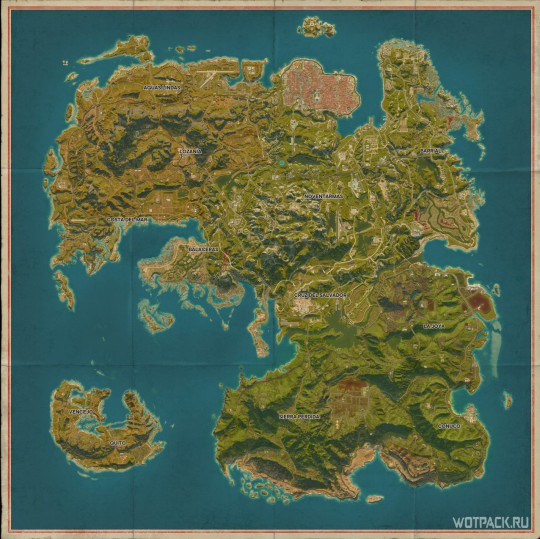
Content has not yet been approved by Yara’s official Office of Tourism. This content has not been approved by the Ministry of Culture and Maria Marquessa can kiss it.
Getting There


Yara has one International Airport, Aeropuerto Internacional de Noventarmas, located in the Valle de Oro region. There are 2 weekly direct flights to and from Miami, Florida. Flights from Yara to Miami are on Mondays at 7:00 and Fridays at 22:00. Check your local listings.
Note: At this time, due to the current situation, there are no official, legal, chartered ships to and from Yara.
Where to Stay

Yara offers accommodations to fit every budget, from luxurious 4-Star hotel to a damp cot in the jungle.
Hotel Paraíso
If safety and luxury is your thing, Hotel Paraíso will be your accommodation of choice. It is located in the heart of the capital city of Esperanza. Make sure to read the "Things to Know Before Visiting Yara" section for important additional information.

Hotel Paraíso, Esperanza, Yara
Beach Resorts
Being a Caribbean island, Yara is naturally surrounded by beautiful sandy beaches and offers many beach side resorts, particularly on the East coast in Barrial.

What To Do in Yara

Outdoor Playground Made in Heaven
Back to Content Index
Yara is a true playground made in heaven for outdoor enthusiasts! Its varied landscapes offer a plethora of outdoor activities. You can go horseback riding, hike endless jungle or cliffside trails; if you prefer speed, you can rent ATV's and blaze through the jungle or a jetski and explore inland rivers, lakes, and the ocean. You can go hunting, fishing or experience the rush of skydiving and base jumping!
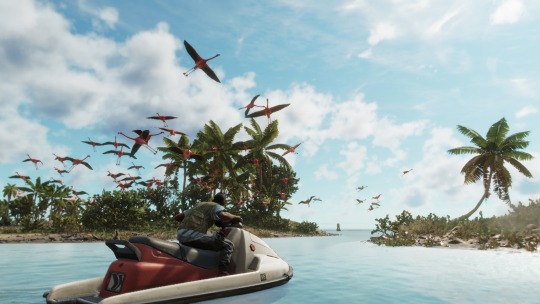

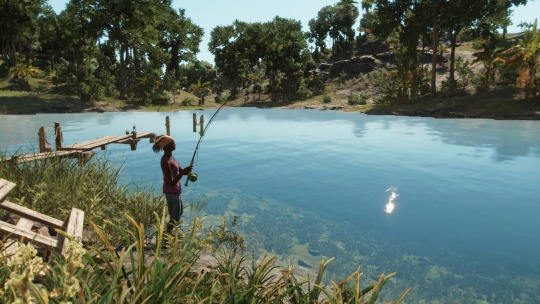

Culture and Architecture
If jumping off a cliff is not really your thing, you may wish to explore Yara's rich history and architecture. It offers many national parks, museums, Churches, there's even a Dino Park!
Stay tuned for future content and information.
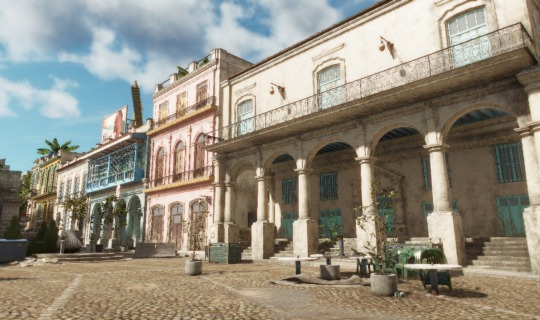
A picturesque street in Esperanza, Yara

Catedral de la Divinidad, Esperanza, Yara
Things to Know Before Visiting Yara
Please read this section carefully for potentially life saving things to know before visiting Yara.
Nighttime Curfews
Due to the current situation, some but not all towns impose a nightly curfew and residents and travelers alike are required to remain indoors between the hours of 8PM to 6AM. In addition to the capital city of Esperanza, towns like Segunda and Concepción are also under curfew. To find out if your city is currently under curfew, pay attention to announcements over the national PA system which will provide information in both Spanish and English.

Carry your Passport and Identification on your person at ALL TIME
Soldados of the Fuerzas Nacionales de Defensa or FND, have the right to demand that anyone produce valid identification at any given time. Just show your papers. It is that simple.
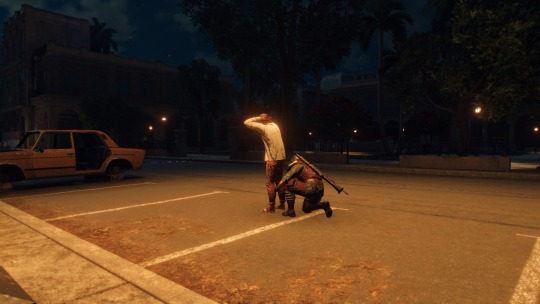

Obey the FND at all times!
Yara is a... ehh.. highly regulated country and is under martial law at this time. As a traveler, it is your duty to obey the rules and regulations at all times to avoid incarceration or--
To avoid incarceration.
Additional rules
There are many rules that may appear strange to foreigners but must be respected to ensure that you remain safe during your stay in Yara.
No public gathering
In light of recent events which resulted in violent protests, public gatherings of 6 people or more are prohibited and will be met with swift action by the FND. If you are traveling in a group, you can obtain a special permit from the Ministry of Culture.
Restricted Areas and Additional temporary entry restrictions
Yara is big on safety and signs. As you travel in Yara, you will encounter many signs prohibiting or restricting access to military sites and government owned and operated facilities. DO NOT TRESPASS IN YARA. Ever. Additionally, you may see areas that are not normally restricted add temporary restrictions at certain times, such as events organized by the Ministry of Culture, public executions, or public appearances by El Presidente de Yara, Antón Castillo.
Restrictions on Tobacco
Smoking of tobacco is not illegal in Yara, however, it is not permitted to possess more than 25 grams, the equivalent of two packs of cigarettes, at any one time.
For more information on activities, places, events, and all things Yara, come back and visit this site often!

A lot more content coming soon!
Back to Content Index
Editor’s Note:
You may be aware that there is another airport in Yara, Aeropuerto Gabriel Castillo De La Joya near Concepción on the very tip of Yara’s east coast, however, it was not mentioned in this section as it is no longer being used for international flights. The airport has been converted to a military airport. A photographer who will remain anonymous for safety reasons may or may not have momentarily trespassed to bring you these few photographs.
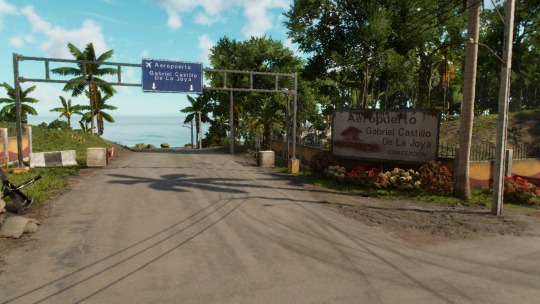

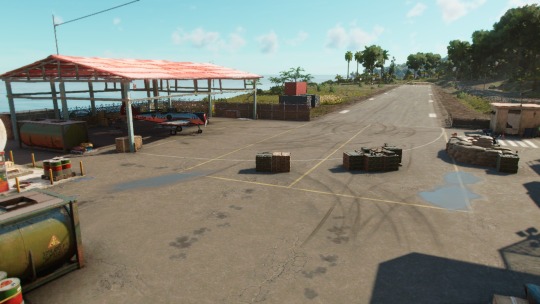
Back to Content Index
44 notes
·
View notes
Text
Sunday, June 2, 2024
UN refugee chief says 114 million have fled homes because nations fail to tackle causes of conflict
(AP) The number of people fleeing their homes because of war, violence and persecution has reached 114 million and is climbing because nations have failed to tackle the causes and combatants are refusing to comply with international law, the U.N. refugee chief said Thursday. In a hard-hitting speech, Filippo Grandi criticized the U.N. Security Council, which is charged with maintaining international peace and security, for failing to use its voice to try to resolve conflicts from Gaza, Ukraine and Sudan to Congo, Myanmar and many other places. He also accused unnamed countries of making “short-sighted foreign policy decisions, often founded on double standards, with lip service paid to compliance with the law, but little muscle flexed from the council to actually uphold it and—with it—peace and security.” Grandi said non-compliance with international humanitarian law means that “parties to conflicts—increasingly everywhere, almost all of them—have stopped respecting the laws of war,” though some pretend to do so.
After Trump’s Conviction, a Wary World Waits for the Fallout
(NYT) The world does not vote in American presidential elections. Nor do its jurors play a part in the American judicial system. Nevertheless, the conviction of Donald J. Trump on all 34 felony counts in a hush-money trial in a New York court on Thursday has again made clear how consequential what happens in the United States is for the rest of the planet. Many America-watchers are grappling with the same questions posed by people in the United States: Can Mr. Trump still run for president? (Yes.) And if so, will the guilty verdicts cut into the support from his political base? (Unclear.) Foreign observers also began wondering if Mr. Trump, already a volatile force, would become even less likely to stay within the guardrails of normal politics and diplomacy if he won the presidency again in November.
Mexican candidate assassinations hit grim record ahead of Sunday’s election
(Reuters) Mexico’s election is now the bloodiest in its modern history after a candidate running for local office in central Puebla state was murdered on Friday at a political rally, taking the number of assassinated candidates to 37 ahead of Sunday’s vote. Jorge Huerta Cabrera, a candidate who was running for a council seat in the town of Izucar de Matamoros, was gunned down in the attack, according to the state prosecutor’s office. The killing takes the number of assassinated candidates in the 2024 election season to 37, one more than during the 2021 midterm election.
Panama prepares to evacuate first island in face of rising sea levels
(AP) On a tiny island off Panama’s Caribbean coast, about 300 families are packing their belongings in preparation for a dramatic change. Generations of Gunas who have grown up on Gardi Sugdub in a life dedicated to the sea and tourism will trade that next week for the mainland’s solid ground. The Gunas of Gardi Sugdub are the first of 63 communities along Panama’s Caribbean and Pacific coasts that government officials and scientists expect to be forced to relocate by rising sea levels in the coming decades. Gardi Sugdub is only about 400 yards (366 meters) long and 150 yards (137 meters) wide. Every year, especially when the strong winds whip up the sea in November and December, water fills the streets and enters the homes. The Gunas have tried to reinforce the island’s edge with rocks, pilings and coral, but seawater keeps coming. Residents will move to the new site on the mainland that the government developed at a cost of $12 million. The concrete houses sit on a grid of paved streets carved out of the lush tropical jungle just over a mile from the port, where an eight-minute boat ride carries them to Gardi Sugdub.
Cuba laments collapse of iconic sugar industry
(BBC) Cutting cane is all Miguel Guzmán has ever known. He comes from a family of farm hands and started the tough, thankless work as a teenager. For hundreds of years, sugar was the mainstay of the Cuban economy. It was not just the island’s main export but also the cornerstone of another national industry, rum. Older Cubans remember when the island was essentially built on the backs of families like Mr Guzmán’s. Today, though, he readily admits he has never seen the sugar industry as broken and depressed as it is now—not even when the Soviet Union’s lucrative sugar quotas dried up after the Cold War. Spiralling inflation, shortages of basic goods and the decades-long US economic embargo have made for a dire economic outlook across the board in Cuba. But things are particularly bleak in the sugar trade. Last season, Cuba’s production fell to just 350,000 tonnes of raw sugar, an all-time low for the country, and well below the 1.3 million tonnes recorded in 2019. “It’s a disaster. Today the sugar industry in Cuba almost doesn’t exist,” says Juan Triana of the Centre for Studies of the Cuban Economy in Havana. “We’re producing the same quantity of sugar Cuba produced in the middle of the 19th Century.”
NATO ministers meet in Prague as allies ease restrictions on Ukraine’s use of their weapons
(AP) NATO foreign ministers were meeting in the Czech capital Friday to prepare for this summer’s leaders’ summit as the alliance boosts support for Ukraine and countries one-by-one remove restrictions on how Kyiv can use western-supplied weaponry to combat Russia’s invasion. A day after U.S. President Joe Biden gave Ukraine the go-ahead to use American munitions to strike inside Russia for the limited purpose of defending Kharkiv, numerous ministers, including those from the Netherlands, Finland, Poland and Germany, expressed approval of the decision, saying that Ukraine has the absolute right to defend itself from attacks originating on Russian soil.
The Kremlin is all-in on war in Ukraine
(CSM) Amid its grinding war of attrition and economic mobilization against Ukraine, Russia is changing fast. As the Defense Ministry spends ever-increasing amounts of money to procure the equipment it needs and to recruit more soldiers, the country’s business environment and economic geography are being reshaped. And the military-industrial complex, which was vastly downsized in post-Soviet years, is reviving quickly. Confounding observers in many ways, Russia’s war economy, despite Western sanctions, is now back at a level that outproduces the entire West in some key military goods. And the Kremlin appears to be committed to a war economy approach for the long haul, as suggested by the recent reshuffling of Defense Ministry leadership. Whether such an economic policy is viable is in debate. Optimists say the rapid economic development is economically positive on balance, or at least that Russia can sustain high levels of military spending for the foreseeable future. Pessimists argue that the Kremlin is building a permanent war economy, much like the one that strangled the Soviet Union, and that hopes of building a prosperous consumer economy are fast vanishing. But for the moment, Russian President Vladimir Putin appears all in.
Voting begins in the last round of India’s election
(AP) A six-week-long national election in India that is a referendum on Hindu nationalist Prime Minister Narendra Modi’s decade in power neared its end Saturday as the last phase of voting began. The election is considered one of the most consequential in India’s history. If Modi wins, he’ll be only the second Indian leader to retain power for a third term after Jawaharlal Nehru, the country’s first prime minister. The seventh round of polls covers 57 constituencies across seven states and one union territory. It will complete a national election to fill all 543 seats in the powerful lower house of parliament. Nearly 970 million voters—more than 10% of the world’s population—were eligible to elect a new parliament for five years. More than 8,300 candidates ran for the office. Most polls show Modi and his Bharatiya Janata Party leading over the broad opposition alliance that’s challenging them, led by the Congress party. The votes will be counted Tuesday, with results expected by the end of the day.
Israeli views of the Israel-Hamas war
(Pew Research Center) Some 39% of Israelis say Israel’s military response against Hamas in Gaza has been about right, while 34% say it has not gone far enough and 19% think it has gone too far, according to a survey conducted March 3-April 4. But Israelis see the war in vastly different ways depending on their political ideology, religion and other factors, including stark divides between Jews and Arabs. According to the survey, conducted in March and early April, roughly two-thirds of Israelis are also confident that Israel will either probably (27%) or definitely (40%) achieve its goals in the war against Hamas.
Israel confirms its forces are in central Rafah in expanding offensive in the southern Gaza city
(AP) The Israeli military confirmed Friday that its forces are operating in central parts of Rafah in its expanding offensive in the southern Gaza city. Israel launched its ground assault into the city on May 6, triggering an exodus of around 1 million Palestinians out of the city and throwing U.N. humanitarian operations based in the area into turmoil. Still, it has yet to amount to a “major operation” in the eyes of U.S. President Joe Biden’s administration, according to the State Department. Up to around 300,000 people are believed to remain in the Rafah area, with an unknown number still in the city itself. Most have flocked to rural areas on the Mediterranean coastline west of the city, said Shaina Low, a spokesperson for the Norwegian Refugee Council, a humanitarian group that operates in the area. That area has seen deadly Israeli strikes the past week. Palestinians who fled the city have scattered around southern and central Gaza, most of them living in squalid tent camps.
Israel maintains a shadowy hospital in the desert for Gaza detainees. Critics allege mistreatment
(AP) Patients lying shackled and blindfolded on more than a dozen beds inside a white tent in the desert. Surgeries performed without adequate painkillers. Doctors who remain anonymous. These are some of the conditions at Israel’s only hospital dedicated to treating Palestinians detained by the military in the Gaza Strip, three people who have worked there told The Associated Press, confirming similar accounts from human rights groups. While Israel says it detains only suspected militants, many patients have turned out to be non-combatants taken during raids, held without trial and eventually returned to war-torn Gaza. Eight months into the Israel-Hamas war, accusations of inhumane treatment at the Sde Teiman military field hospital are on the rise, and the Israeli government is under growing pressure to shut it down. Rights groups and other critics say what began as a temporary place to hold and treat militants after Oct. 7 has morphed into a harsh detention center with too little accountability.
Google scales back AI search answers after it told users to eat glue
(Washington Post) Google said it was scaling down the use of AI-generated answers in some search results, after the tech made high-profile errors including telling users to put glue on their pizza and saying Barack Obama was Muslim. The change is the latest example of Google launching an AI product with fanfare and then rolling it back after it goes awry. The tech industry is in the throes of an AI revolution, with start-ups and Big Tech giants alike trying to find new ways to put the tech into their products and make money from it. Many of the tools have been launched before they’re ready for prime time, as companies jostle to be the first to market their products and cast themselves as cutting-edge. One answer, which Google has since fixed, told people to drink plenty of urine to help pass a kidney stone. Another said John F. Kennedy graduated from the University of Wisconsin at Madison in six different years, three of which were after his death.
3 notes
·
View notes
Text

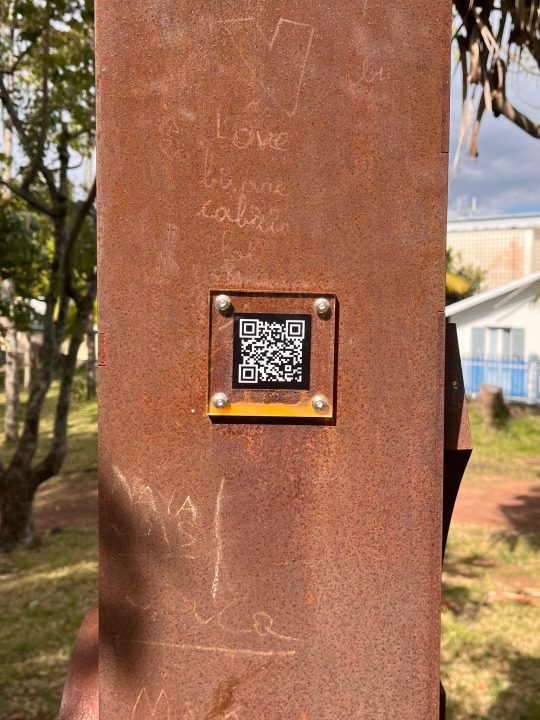
Caught an aloalo reference from afar. I was amazed to find a memorial for the marons in front of the tourism office, with the malagasy roots explicitly representated (aloalo are funeral sculptures from the Mahafaly region). Major maronaz sites have yet to be given memorials; the few that’ve been installed seem to come with a QR code leading to a tantara (gasy tale/legend) in a podcast form. Sat under a tree, listened to it as birds were flying around the parc, the tantara being Zoizo la liberté (Freedom bird). Cannot describe how proud I felt.
Dimitile is where we celebrate Atidamba (honoring marons and afro/malagasy ancestors) This year’s the 360th anniversary of Reunion Island peopling. In 1663, 10 malagasy and 2 frenchs arrived from Fort-Dauphin MDG. The frenchs quickly left leaving the malagasy on the island. 1 of them is my direct ancestor, as many Creoles. They became the first marons. Basically this island is malagasy fr
(Dimitile memorial, Arboterum de l’Entre-Deux)
19 notes
·
View notes
Text
Rio gangsters torch at least 35 buses after Brazil crime boss killed

Criminal groups set at least 35 buses on fire in the Brazilian city of Rio de Janeiro on Monday, according to the industry group that represents bus companies, after police killed a crime boss in an operation.
The attacks on buses were concentrated in the west of the city, where rival criminal groups are fighting for territorial control. They came after a police operation that killed the nephew of the leader of the state's largest militia, according to the police.
Rio's so-called militias, often composed of current and former police officers, have become one of the region's largest security threats. Originally set up as self-defense forces for poor neighborhoods blighted by drug gangs, they have now metastasized into criminal outfits operating in multiple different rackets.
Industry group Rio Onibus said 20 of the vehicles were city buses, five were part of the city's rapid transit fleet and the remainder were chartered or tourism buses.
Continue reading.
5 notes
·
View notes
Text
We spent Friday with a tour company that likes to go off the beaten path, called We Hate Tourism Tours (we’ve learned that the Portuguese have a very sarcastic sense of humor). They took us to the Mountains of Sintra and beach dunes of Cascais, sites of Portuguese royalty escapism during historical hardships.
We were two of six on the tour group, but the other 4 wanted an exclusive tour in German without any pesky English. So they split us up and we spent the entire day with our tour guide, Mannu, handcrafting a personalized tour.

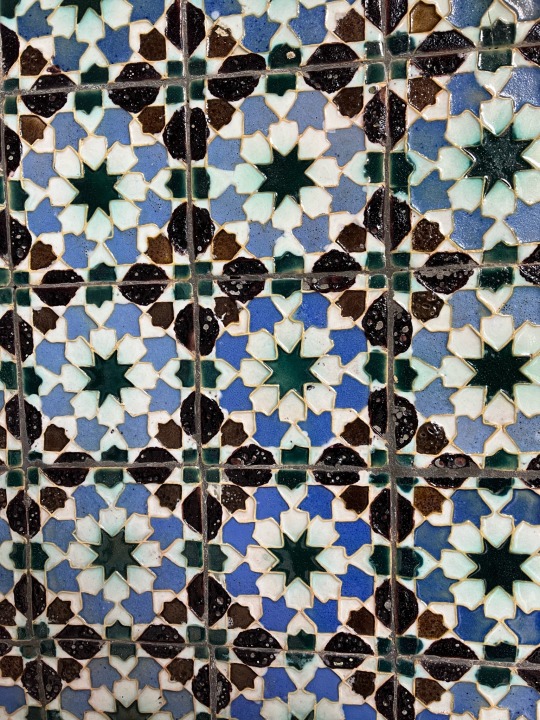
In the mountains we visited Miradouro de Santa Eufémia, Sintra National Palace, Palace and Park Biester (Cat will add a part 2 with more pictures from the palace), and Palace and Park Montserrate. The mountain would naturally be bare granite, but it's ideal climate encouraged the Portuguese to plant forests of pine trees (lumber for Portuguese ships) and cork trees (cork for wine bottles). The palaces of Sintra were royal retreats especially during the hot summer months and the Castle of the Moors (the right most red arrow below) still stands from the 700s.
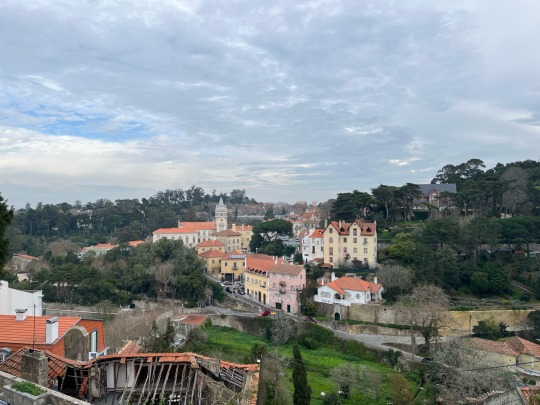
Mannu took us to Pão Saloio (roughly translated to Hillbilly Bread) for a classic rural lunch of breads, chorizo, pork belly, cheese, olives, and tomatoes and Cat was introduced to Green Wine - wine made with grapes that are not fully ripened due to the weather conditions of Portugal. We knew it was going to be good when we saw a group of police officers hanging around smoking and having their coffees.
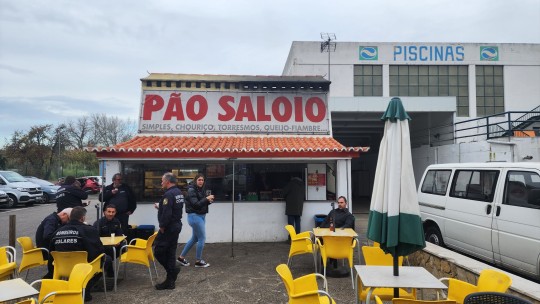
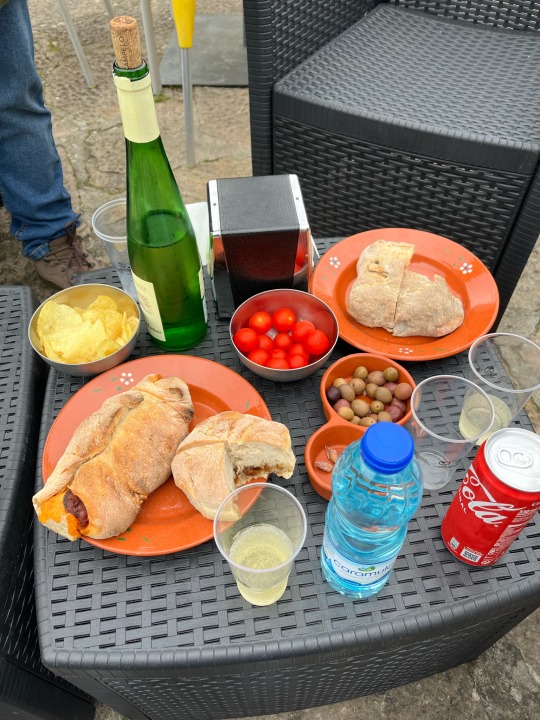
Our last stop on the mountain was the western most point of continental Europe, Farol do Cabo da Roca (the left most red arrow below and pictured below).


We made it way down to the beachy dunes of Cascais. Cascais was a retreat for some King I forget the name of who sought to get away from the throngs of people following him all the time so he went to the village or fishermen as he thought the smell would keep the bourgeois away...
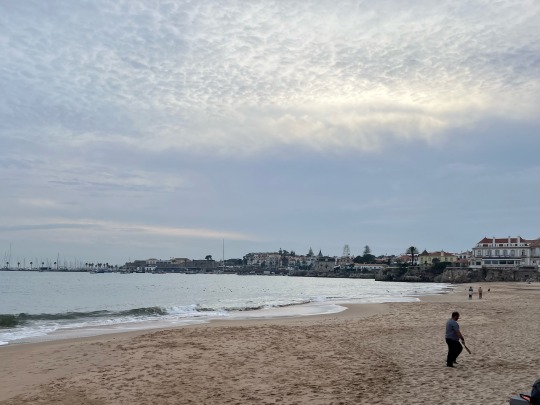
After many stops admiring the waves (Mannu was a surfer and could not believe the conditions on the day), we circled back to Lisbon where we had a lovely dinner of tempura green beans, steak, cod, clam rice, truffle mashed potatoes and another glass of green wine for Cat. I struggled to stay awake during dinner, so Cat only made two pit stops for shopping as we walked back to our airbnb.
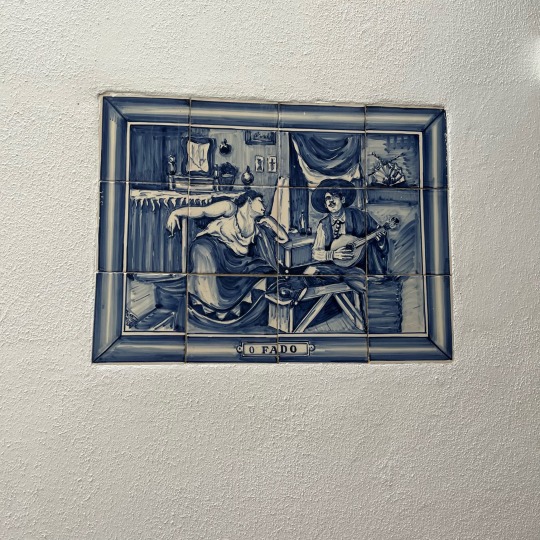

I was asleep by 8 :)
3 notes
·
View notes
Text
Although many surprises undoubtedly lurk down river, it is already clear that the advent of ‘catastrophic terrorism’ in tandem with what may likely be the worst recession since 1938 will produce major mutations in the American city. There is little doubt, for instance, that bin Laden et al have put a silver stake in the heart of the ‘downtown revival’ in New York and elsewhere. The traditional central city where buildings and land values soar toward the sky is not yet dead, but the pulse is weakening. The current globalization of fear will accelerate the high-tech dispersal of centralized organizations, including banks, securities firms, government offices, and telecommunications centres, into regional multi-site networks. Terror, in effect, has become the business partner of technology providers like Sun Microsystems and Cisco Systems, who have long argued that distributed processing (sprawling PC networks) mandates a ‘distributed workplace’. In this spatial model (of which the Al-Qaeda network might be an exemplar), satellite offices, telecommuting and, if the need be, comfortable bunkers will replace most of the functions of that obsolete behemoth, the skyscraper. Very tall buildings have long been fundamentally uneconomical; indeed the absurdly overbuilt World Trade Centre—a classic Rockefeller boondoggle—was massively subsidized by public-sector tenants.footnote23 (Will the hijacked airliners someday be seen as having played the same role in the extinction of skyscrapers as the Chixulub asteroid in the demise of dinosaurs?)
[...]
Despite massive plans for ‘hardening’ and ‘terror-proofing’ downtown public spaces and monumental buildings, however, most white-collar workers and managers will prefer to consume enhanced security closer to their suburban homes.footnote24 Physical security retrofits—the reinforcement of building structures, vapour-and-trace detection systems, bollards and traffic barricades, bomb mitigation containers, smart doors, metal detectors, bomb-proof trash cans, biometric surveillance portals, reduced surface and underground parking, and so on—will impose huge and unavoidable expenses for cities trying to shore up their downtown economies, but they are unlikely to stem the new exodus of jobs and tax resources. Massive public-sector subsidies to developers and corporate tenants likewise may slow but probably won’t reverse the trend toward deconcentration. In addition, as self-advertised ‘world cities’ hunker down for the long siege, urban economists and fiscal analysts must wrestle with the new demon of ‘de-globalization’: the portion of global service production and international tourism that may be lost forever.
I sometimes think back on the “fortress suburbia“ vision of ~2000 where locked-up suburban subdivisions would be opposite total urban blight that seemed like the inevitable future, instead we got “gentrification” as the major issue of ~2010. Seemed like that might happen with covid too, although that’s still up in the air it seems like I’m not gonna get lucky enough to have my area blighted and get a goddamn rent reduction.
35 notes
·
View notes
Text

.
Thursday Throw Back… Rails with no train
Walking around the arcades on place des Vosges, away from the side with many art galleries and not far from the oldest graffiti, one will notice rails at the entrance to the porte cochère of the Hôtel de Rotrou. According to the Office de tourisme de Paris, "this building was simply the headquarters of the Compagnie internationale des wagons-lits, and this door gave access to the kitchens, which supplied the stations". Dishes were loaded onto the rails and then onto trucks in the square, before being transported all over Paris in these refrigerated trucks. Sandwiches and snacks for Paris stations and the Grands Hôtels des Wagons-lits were prepared and packaged at Place des Vosges until 1954.
The company was founded in 1872 by Belgian businessman Georges Nagelmackers. Inspired by the model of the night trains launched in the United States by Colonel Pullman's company, with whom he formed an early partnership, he built Europe's first sleeping and dining cars, and in 1883 launched the Grand Express d'Orient between Paris and Constantinople, which became the famous Orient-Express, and the Rome-Express between Calais and Rome, via Paris.
3 notes
·
View notes
Text
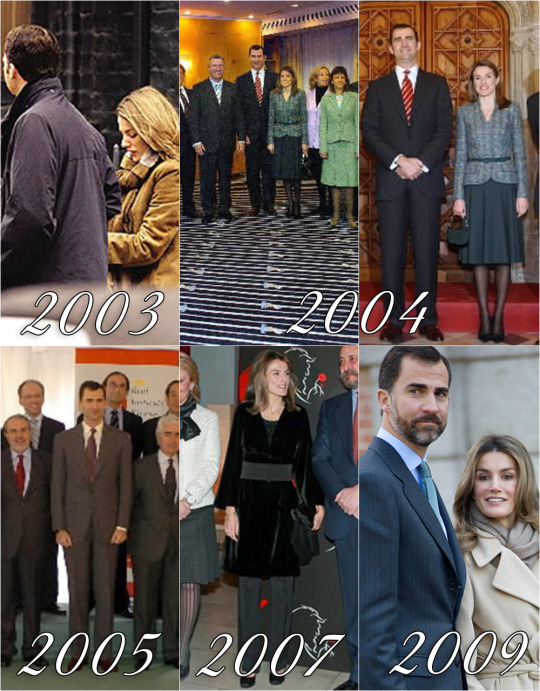

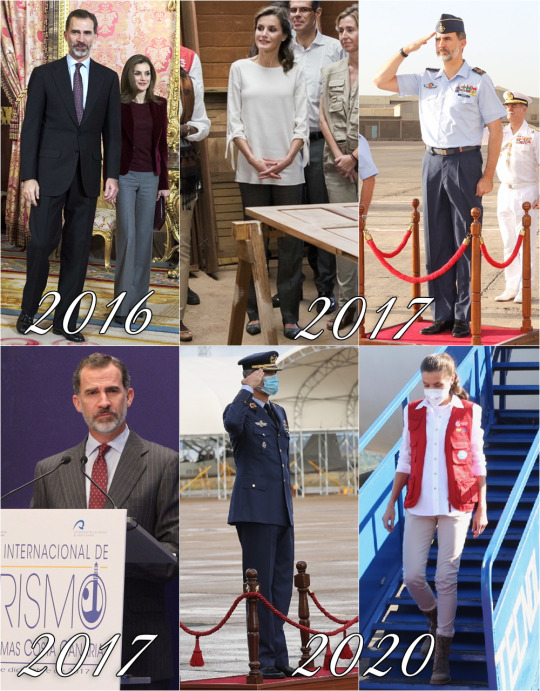

Felipe and Letizia retrospective: December 14th
2003: Weekend in London.
2004: Audience to the Junta Directiva del Club de Encuentros “Manuel Broseta” (the alicantin lawyer who was killed by ETA in 1992); Inauguration of the newspaper office of “Las Provincias Multimedia” in Valencia & 16th King Jaime I awards
2005: Meeting of the Board of Trustees of the Royal Institute of International and Strategic Studies
2007: Attended the musical “Beauty and the Beast” in benefit the Children’s Oncology Residence of the Spanish Association against Cancer
2009: Lunch offered to the president of Vietnam Nguyen Minh Triet; Meeting with Presidents of Communities and Autonomous Cities attending the 4th Conference of Presidents & Gala dinner offered to the president of Vietnam Nguyen Minh Triet
2011: Prince of Girona Foundation presentation in Barcelona
2012: Audiences at la Zarzuela
2014: Lunch with her team at a restaurant near la Zarzuela
2015: 13th meeting of the patronages of the Princess of Girona Foundation
2016: Meeting of Princess of Girona Foundation at the Royal Palace in Madrid.
2017: Visited Village Pilote initiative for kids of the streets in Dakar, Senegal as part of her four-day cooperation trip to the west African country; Visited Ala 46 (Group 82) of the air force in Las Palmas & Lunch for the 5th International Forum of Tourism, Maspalomas Costa Canaria
2020: Visited military facilities of the Spanish Air Force & Arrived in Honduras for a cooperation trip
2021: Lunch celebrating the 15th anniversary of the newspaper “elEconomista”
2022: Inaugurated the exhibition “De Territorios 5x50”, one of the events in celebration of the 50th anniversary of the UNED & Delivered the 19th edition of the Annual Awards of the Victims of Terrorism Foundation
F&L Through the Years: 1099/??
#King Felipe#Queen Letizia#King Felipe of Spain#Queen Letizia of Spain#King Felipe VI#King Felipe VI of Spain#F&L Through the Years#December14
5 notes
·
View notes
Photo






On November *22nd 1888 the Sword, reputed to be that of Sir William Wallace was taken to The National Wallace Monument.
*And yet another with differing dates
The sword’s history is as significant as that of the Stone of Destiny. It is said that after the capture of Wallace, the sword was taken to Dumbarton Castle and kept for almost 600 years. Despite protests from the people of Dumbarton, in 1888 the sword was installed in the monument with great pomp and ceremony.
The people of Dumbarton let it be known……
“The Dumbarton Town Council feel aggrieved at the removal of Wallace’s sword from the castle to the Wallace Tower on Abbey Craig, and have resolved to remonstrate with the War Office authorities, and ask that the historic weapon be returned to the place where it has lain for between five and six hundred years.”
In 1912 the case containing the sword was broken by a suffragette called Ethel Moorhead to highlight the struggle to obtain votes for women, and it was stolen in 1936 and again in 1972 but on each occasion it was safely recovered and returned.
The history of the sword itself has been questioned, most recently in 2020 Dr David Caldwell, former president of the Society of Antiquaries of Scotland, said that it had “nothing to do” the leader of the First War of Independence, who lived from 1270 to 1305.He described the sword as a “not very good example of a two-handed 16th Century sword” which was acquired in “desperation” to link the monument to Wallace.
To me it is secondary, just like the aforementioned Stone of Destiny’s history is disputed, the Wallace sword is more of a symbolic symbol for Scots.
Information promoted by the National Wallace Monument said that “it is believed” that the Wallace Sword was left at Dumbarton Castle from 1305 after Wallace was imprisoned there. A mention of ‘Wallace’s sword’ later appears in accounts of the Lord High Treasurer of Scotland in 1505;
......at the command of James IV., the sum of twenty-six shillings, equal to about thirty pounds at our present money, was paid to an armorer for binding a riding sword and a rapier; also for the “binding of Wallas sword with cords of silk”, and providing it with “ane new hilt and plomet” also with a “new scabbard and a new belt.”
While the rapier and the riding sword are named as being simply repaired, the Wallace sword is described as adorned with trappings of silk; also as having been furnished with the specified additions of a new hilt and pommel, a new scabbard and a new belt.
Ken Thomson , of Stirling District Tourism, which runs the National Wallace Monument, said the sword was “held in high respect” during the 1800s when Scotland experienced a surge in patriotism.
When it was brought to Stirling in 1888, Provost Yellowlees said: “…no true Scotsman could look upon this sword without having anew a feeling of gratitude to the patriot who wielded it, and who bled and died to secure for his country that liberty which to him was dearer than life”.
The quote in the first pic is by Sir Walter Scott, which surely means he believed in the swords history? The sword measures 1.68m and weighs approximately 3kg.
The last pic is of interest, the information tagged to it reads “Swords of Scottish Heroes Exhibited at the Laying of the Foundation Stone of the Wallace Monument at Stirling 1. Sir William Wallace's 2. King Robert Bruce's 3. Sir John De Graeme's 4. Sir Richard Lundin's 5. The Black Douglas's”
I’ve posted about all these before except Sir Richard Lundin, the sword is said to be of the same era as The Wallace sword, and that he carried it into battle at The Battle of Stirling Brig, however he was one of those that chopped and changed sides and was in King Edwards Army.
He advised Sir Hugh Cressingham, Edward I’s appointed Lord Treasurer of Scotland, that to cross Stirling bridge itself would result in certain loss. He has been attributed with the following speech.
“My Lords if we go on to the bridge we are dead men; for we cannot cross it except two by two, and if the enemy are on our flank, and can come down on us as they will, all in one front. But there is a ford not far from here, where we can cross sixty at a time. Let me therefore have five hundred Knights and a small body of infantry, and we will get round the enemy on the rear and crush them”
Cressingham ignored the advice of the skilful soldier Sir Richard, and the battle was lost. After this Sir Richard fought with Wallace and is believed to have become a good friend. Sir Richard is listed as one of the Nobles of Scotland who appointed Sir William Wallace to the position of Governor of the Kingdom. They fought together at Falkirk. The sword of Sir Richard de Lundie, laird of Lundin, friend of Wallace, was taken to the ceremony of laying the foundation stone for the Wallace Monument.
This sword is now at Drummond castle, ancestral home of the Earls of Perth, at one time descendants of Lundin of that ilk.
Such is the unsure history of this era it is interesting to note that “Lundie” is described in Blind Harry’s depiction of the battle of Stirling bridge as being on the side of the Scots.
The hardy Scots with heavy strokes and sore,
Attack the twenty thousand that came o'er.
Wallace and Ramsay, Lundie, Boyd, and Graham,
With dreadful strokes made them retire - Fy, shame!
I have tried to find a real photo of the Lundie sword, but to no avail, Drummond Castle being a privately owned and only the gardens are open to the public.
#Scotland#scottish#Sir William Wallace#the national wallace monument#weapon#medieval weapon?#history#abbey craig#stirling
26 notes
·
View notes
Text
1 novembre :
Matinée dédiée aux corvées: séchage de tente et du sac de couchage, nettoyage des chaussures et de la popote, lessive, etc. L'après midi je constate avec regret que le seul musé qui m'intéressait est fermé car c'est jour férié. Pas grave je fais un massage "Inka" à la place. Les dommages du sac lourd sont rafistolés et la masseuse me met des pierres brûlantes sur tout le corps.... autant je pense bien tenir le froid, mais c'est au détriment de ma tolérance à la chaleur... J'espère que ça sert à quelque chose au moins. Le soir je mange une pizza familiale et je refais mon stock de calorie. Puis bus de nuit pour Puno sur le lac Titicaca.
2 novembre :
Arrivé au aurores, je pose mon sac à l'hôtel et j'enchaîne avec un tour organisé à la journée sur ce lac situé à 3800m d'altitude et dont la superficie est égale à 14 fois celle du lac Lémen. Je m'attends au pire pour cette journée d'attraction touristique, mais le lac est sur mon chemin vers La Paz, autant en profiter. On commence par visiter les îles flottantes (artificielle, en roseau) Uros où habitent les communautés du même nom. Elles ont abandonné leur activités de pêche pour se dédier exclusivement au tourisme (Ça a dû être sympas le covid). Puis visite de Amantani, une autre île avec d'autres communautés où on y fait une ballade de 1h. Puis retour à Puno (~6h de bateau en tout). Pizza et 1er Pisco Sour après quasiment 1 mois au Pérou et à la veille de mon départ pour la Bolivie.
3 novembre :
Bus pour Copacabana, ville supposée charmante au bord du lac Titicaca côte Bolivien d'où plusieurs excursions peuvent se faire, comme par exemple la fameuse Isla del Sol. Je n'y resterai que 1h le temps de manger et visiter la cathédrale... J'ai besoin de hautes montages andines, pas de paysages grecs de qualité contrefaçon chinoise. Donc bus pour La Paz. Ce qui me fera une journée transport mais sans regrets.
4 novembre :
Visite de la très moche La Paz. Bon je suis un peu sévère, elle a un certain charme mais uniquement lorsque contemplée de façon très macroscopique. En prenant par exemple le téléphérique qui fait office de métro, on peut prendre de l'altitude et admirer la ville qui s'étant dans une cuvette (et qui y déborde allègrement) avec au loin des glaciers. Les panoramas sont impressionnants sur cette "Toulouse" (tout est en brique mais je ne penses pas que ce soit pour des raisons esthétiques) et je passe 2h dans le téléphérique à faire toutes les lignes possibles. Sinon je visite quelques églises et me ballade à pied dans la ville, mais franchement c'est pas Rome.
5 novembre :
Parmis les glaciers qui dominent au loin La Paz il y a le Huayna Potosi à 6077m (!!!), et comme il fait beau les 3 prochains jours, je m'embarque dans une rando vers son sommet. Le premier jour (sur 3) consiste à rejoindre le camp bas (4800m) en voiture et de s'entraîner avec les crampons et piolets sur une langue du glacier qui s'étend pas loin du refuge. 1er expérience pour moi avec un tel équipement et dans un tel environnement. Je prends du plaisir à marcher sur le glacier puis de grimper un mur de 10m. Évidement je suis encordé et j'ai un guide personnel. Journée tranquille physiquement et nuit dans un refuge confortable où je fais la connaissance d'un groupe de 10 personnes avec qui je passerai les 2 prochains jours.
6 novembre :
Grasse matinée. Pour des raisons d'organisation entre les groupes qui se succèdent vers le refuge "haut" (5270m) et d'acclimatation pour les fragiles (comme moi il y a maintenant un mois) la journée sera tranquille aussi. Vers 12h00 on part pour le prochain refuge. Je fais le trajet tout seul, sans suivre le groupe, en 1h. J'avoue être particulièrement en forme, je suis très excité de faire mon 1er sommet > 6000m. Mon rythme impressionne les guides et le groupe qui me suit. Du coup mon guide décidera de me faire partir du refuge pour grimper le sommet 1h après les autres. Sinon je risque d'arriver trop tôt pendant la nuit et de me geler les gamètes mal. Mais avant cela on dîne à 17h00 et se couche à 18h00. Réveil prévu pour 00h30 mais j'ai vraiment du mal à dormir, j'ai mal à la tête. Mais c'est le seul symptôme de l'altitude. Au Kilimandjaro c'était bien pire, et cette référence me donne de la force et je reste très positif pour l'ascension.
7 novembre :
Au réveil je pense avoir tout de même réussi à dormir 1h, et surprise, je n'ai plus mal à la tête. J'avale le petit dej, enfile crampons et harnais et c'est partit pour l'aventure. Tous les voyants sont au vert lorsqu'on commence, avec mon guide, à marcher sur le glacier. Je suis forme, je n'ai pas froid (je ne porte pas ma doudoune et il fait -7°C), pas de symptômes de mal d'altitude, la glace n'est pas couverte de neige et les crampons accrochent bien. Ce qui fait qu'on fonce, on double tout le monde et 3h30 plus tard on arrive au sommet, tous seul. Les 2es plus rapides atteindrons le sommet en 5h. Mais il fait encore nuit et on attend 1h dans le froid que le soleil se lève. Les paysages me réchauffent les yeux et par conduction thermique tout le corps (et non le boulot ne me manque pas!). Après la séance photos mais sans le drone (que j'ai trimballé mais qui a complètement gelé le rendant HS pour le moment), nous entamons la descente. Je prends conscience alors des paysages, de jour cette fois, et j'embête mon guide à faire plein de pauses pour capter par caméra les vues (le drone a décongelé). Arrivé au refuge je fais une siete en attendant les autres, qui seront dans l'incompréhension totale lorsque je leur donne mon temps d'ascension. Mon ego est flatté, surtout que je n'ai pas l'impression d'avoir poussé mes limites physiques. Puis retour au camp "bas", trajet jusqu'à La Paz, douche, sieste, dîner, bière, dodo.
Bilan Huayna Potosi: 13km, 1500m d+ (l'effort n'est pas du tout représentatif de ces stats)
8 novembre :
Et non, pas de repos, réveil à 6h30 pour visiter 2 canyons dans les environs de La Paz: le Canyon de Palca puis la Valle de las animas. C'est assez uniques comme paysages, les canyons s'étant formés dans la terre (bien plus malléable que la roche) et donnant des formes de pâte à modeler faite par un enfant de 3 ans (mais un enfant avec une fibre d'artiste). Sur le chemin je ne croise que des chiens qui me feront sortir de ma zone de confort plus qu'au Huayna Potosi...
Bilan : 21km, 800m d+
3 notes
·
View notes